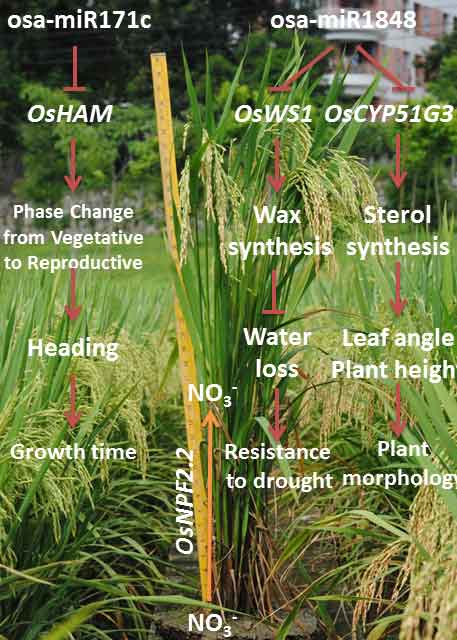Identification of four genes related with agronomic traits of rice
Rice is one of important crops and a model plant for molecular biology. Growth period, nutrition utilization efficiency, stress resistance and ideal plant type are important agronomic traits.
Recently, South China Botanical Garden, Chinese Academy of Sciences, identified four rice genes, which affect above agronomic traits. Li et al found that nitrate transporter gene OsNPF2.2 mediates allocation of nitrate from the root to the upland part of rice, then affects rice growth and development (Scientific Reports 2015, 5: 9635). Fan et al found that osa-miR171c regulates the expression of transcription factor OsHAM, thereby affects phase change from vegetative to reproductive growth, so as to control the growth period of rice (PLoS One, 2015, 10: e0125833). Xia et al found that the osa-miR1848 regulates the expression of rice wax synthase gene OsWS1, which controls the formation of rice leaf cuticular waxes, thereby affects the drought resistance of rice (Plant Cell and Environment, 2015, DOI: 10.1111/pce.12576); In addition, osa-miR1848 also participates in regulation of sterol synthesis by targeting OsCYP51G3, and regulates brassinosteroid and sterol synthesis; therefore, regulation of plant height and leaf angle (New Phytologist, 2015, doi:10.111/nph.13513).
The research was supported by the National Natural Science Foundation of China, the Chinese Academy of Sciences, and the Science and Technology Projects of Guangdong province.

Figure: OsNPF2.2 transports nitrate from roots to upland parts. osa-miR171c targets OsHAM to regulate phase change from vegetative to reproductive growth. osa-miR1848 targets to OsWS1 and OsCYP51G3 to regulate wax and sterol biosynthesis, respectively.
File Download: